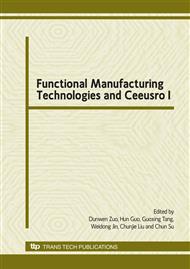p.9
p.13
p.17
p.21
p.26
p.30
p.35
p.40
p.45
Parameters Optimization of Laser Processing CVD Diamond Film Based on FEM Simulation
Abstract:
Chemical vapor deposited (CVD) diamond film has a series of outstanding properties. However, it can not be easily machined by conventional technologies available currently for its high hardness and stability. Laser processing diamond film method can be an efficient way to process diamond film because of its high energy density. The mechanisms of laser processing diamond film are thermal oxidation, graphitization and evaporative ablation of graphite. Temperature distribution is of great importance to understand these complex phenomena taking place during the process because different temperatures lead to different physical and chemical changes of diamond. In this paper, the finite element method (FEM) software ANSYS is applied to calculate the temperature distribution. The relation between etching depth and laser machining parameters (laser power and scanning speed) is presented. The proper parameter ranges of laser power and scanning speed for a certain etching depth is also investigated with this method.
Info:
Periodical:
Pages:
26-29
Citation:
Online since:
January 2010
Authors:
Price:
Сopyright:
© 2010 Trans Tech Publications Ltd. All Rights Reserved
Share:
Citation:


